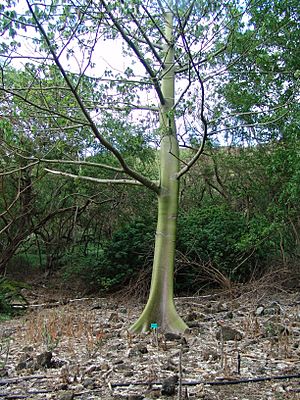East African bombax facts for kids
Quick facts for kids East African bombax |
|
|---|---|
 |
|
| Wild kapok tree | |
| Conservation status | |
| Scientific classification | |
| Genus: |
Rhodognaphalon
|
| Species: |
schumannianum
|
| Synonyms | |
|
|
The East African bombax or wild kapok tree (scientific name: Rhodognaphalon schumannianum) is a fascinating flowering plant. It belongs to the Malvaceae family, which also includes cotton and hibiscus. This tree is native to parts of East Africa, where it plays a role in local ecosystems and traditions.
Contents
What is the Wild Kapok Tree?
The wild kapok tree is a type of plant that grows in warm climates. It is known for its seeds, which are quite useful. The tree's scientific name, Rhodognaphalon schumannianum, helps scientists around the world know exactly which plant they are talking about.
Where Does the Wild Kapok Tree Grow?
You can find the wild kapok tree in southeastern Kenya. It also grows along the coasts and in the Eastern Arc forests of Tanzania. Its range extends south into northern Mozambique and Malawi. This means it thrives in tropical and subtropical areas of East Africa.
What Are Its Uses?
One of the most interesting things about the wild kapok tree is its seeds. People in the areas where it grows often collect these seeds. They can be roasted and eaten as a snack. Sometimes, the seeds are ground into a fine powder. This powder is then used in cooking, adding flavor and nutrients to meals.
Is the Wild Kapok Tree Endangered?
The wild kapok tree is currently listed as "Least Concern" by conservation groups. This means that, for now, there are enough of these trees in the wild. They are not considered to be at high risk of disappearing. However, it is always important to protect natural habitats to ensure plants like the wild kapok tree continue to thrive.


